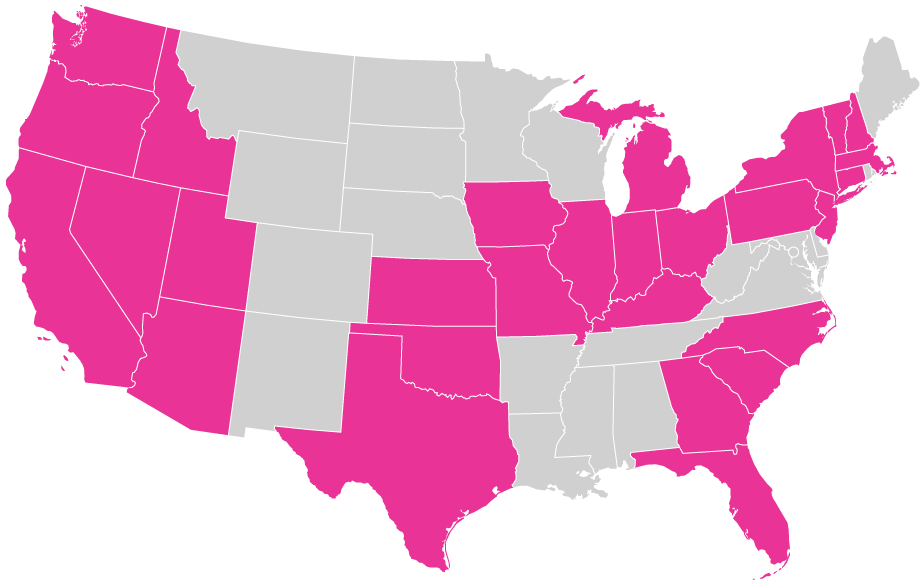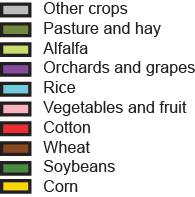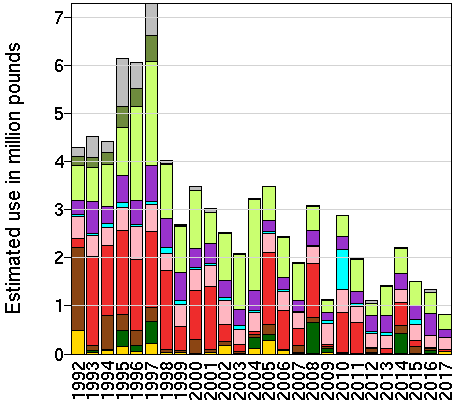Malathion
ma-luh-thai-uhn
High residues found on basil. Registered as a U.S. pesticide in 1956. Reregistered in 2006. Currently under registration review.
Overview
Malathion is used in 28 states.

Malathion is used in Arizona, California, Connecticut, Florida, Georgia, Idaho, Illinois, Indiana, Iowa, Kansas, Kentucky, Massachusetts, Michigan, Missouri, Nevada, New Hampshire, New Jersey, New York, North Carolina, Ohio, Oklahoma, Oregon, Pennsylvania, South Carolina, Texas, Utah, Vermont, and Washington.
Data is not available for Alaska, D.C., Hawaiʻi, and U.S. Territories. Data represents the most recent year available from USGS. Details.
See detailed maps of malathion usage by state and county.
Human Health Effects
Even at low levels of exposure, malathion can lead to serious negative health effects.
Cancer
Neurodevelopmental Harm
Reproductive Toxicity
High Risk Exposure Routes
People are exposed to malathion through food and drinking water, even if they don’t live near areas where pesticides are sprayed. Details.
Food and/or Drinking Water
FarmworkersPeople performing post-application activities in previously treated fields, but do not directly apply pesticides themselves. Details.
Pesticide HandlersPeople involved in pesticide application process. Details.
Residential
Residential BystanderPeople who live near areas where pesticides are applied. Details.
Spray Drift
Wide Area Public Pest Control
High Residue Foods
Where residue levels of malathion exceeded allowable limits or were not legally allowed to have residues.Details.
Basil
Percentage of Crops
Malathion is applied on food widely grown and consumed in the United States.
Caneberries (70%)
Strawberries (55%)
Blueberries (40%)
Celery (30%)
Cherries (25%)
Tangerines (25%)
Registered Uses
Where EPA allows malathion to be used.
Agricultural Crops: alfalfa, fruit and vegetables, orchards and grapes
Outdoor Mosquito Adulticide
Outdoor Residential Use on Gardens / Orchards / Ornamentals / Lawns
Additional Information
Estimated Use of Malathion on Crops
Most recent agricultural crop usage data as provided by the U.S. Geographical Survey’s Pesticide National Synthesis Project. Does not reflect universal usage of malathion. (How do EPest-low and EPest-high differ?)
U.S. Tolerances Categories & Commodities for Malathion
The U.S. EPA sets maximum residue limits — known as “tolerances” — on the amount of malathion that may remain in and on foods. The tolerance is the residue level that triggers enforcement actions.
Tolerances have been set for malathion for: Agricultural Commodities and Milk Eggs Meat and/or Poultry. Maximum residue limits have been set for malathion by the U.S. EPA for the following commodities:
Almond
Apple
Apricot
Asparagus
Avocado
Barley
Beans
Beet
Blackberry
Blueberry
Boysenberry
Carrot
Cattle
Chayote
Cherry
Chestnut
Clover
Corn
Cotton
Cranberry
Cucumber
Currant
Date
Dewberry
Egg
Eggplant
Fig
Flaxseed
Garlic
Goat
Grass
Hazelnut
Hog
Hop
Horse
Horseradish
Kumquat
Leafy Vegetables
Lemon
Lentil
Lespedeza
Lime
Loganberry
Lupin
Macadamia Nut
Mango
Melon
Milk
Mushroom
Nectarine
Oat
Okra
Onion
Orange
Papaya
Parsnip
Passionfruit
Peach
Peanut
Pear
Pecan
Pepper
Peppermint
Pineapple
Plum
Potato
Poultry
Pumpkin
Quince
Radish
Raspberry
Rice
Rutabaga
Rye
Safflower
Shallot
Sheep
Sorghum
Soybean
Spearmint
Squash
Strawberry
Sunflower seed
Sweet Potato
Tangerine
Tomato
Trefoil
Turnip
Vetch
Walnut
Watercress
Wheat
U.S. EPA Human Health Risk Assessments for Malathion
Human Health Risk Assessments are conducted by the U.S. EPA to estimate the nature and probability of harmful health effects in people who may be exposed to pesticide. They are used to make informed decisions about approving new pesticides and new uses of registered pesticides, and during our regular review of existing pesticides. Read the assessment for malathion.


